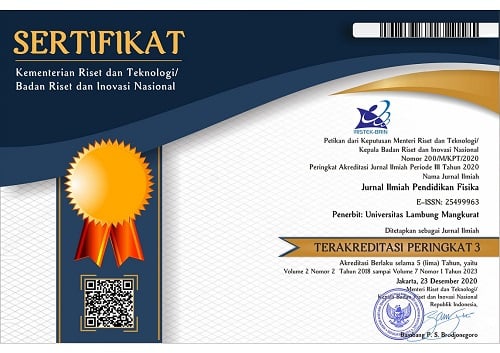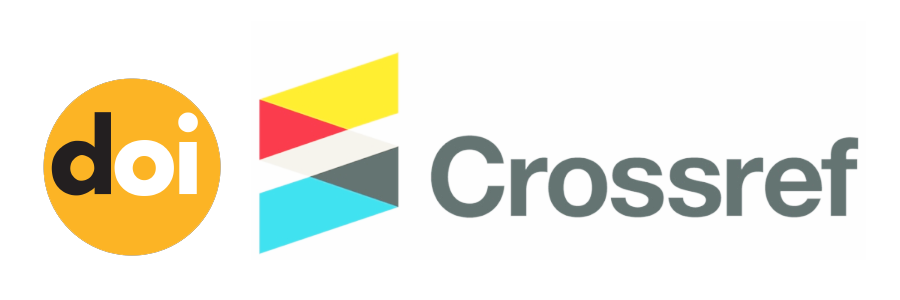Analisis Kebutuhan Video Pembelajaran Bermuatan Keterampilan Pemecahan Masalah untuk Meningkatkan Hasil Belajar
Abstract
Penelitian ini bertujuan menganalisis kebutuhan video pembelajaran bermuatan keterampilan pemecahan masalah untuk meningkatkan hasil belajar. Jenis penelitian yang digunakan adalah penelitian dan pengembangan (Research and Development) dengan desain penelitian ADDIE (analysis, design, development, implementation, dan evaluating). Adapun artikel ini hanya berfokus pada tahapan analisis sebagai bagian dari studi pendahuluan. Subjek uji coba pada penelitian ini ialah 111 orang peserta didik kelas X program MIPA di salah satu SMA Negeri di Banjarmasin. Teknik pengumpulan data diperoleh melalui dokumentasi dan kuesioner. Dokumentasi dilakukan terhadap hasil ulangan harian peserta didik, sementara kuesioner dilakukan dengan menyebar angket secara online mengenai kebutuhan video pembelajaran bermuatan keterampilan pemecahan kepada peserta didik. Analisis data dilakukan dengan menganalisis jawaban hasil ulangan harian peserta didik berdasarkan indikator pemecahan masalah dan menghitung persentase skor angket. Hasil penelitian menunjukkan bahwa: (1) dari lima indikator pemecahan masalah, indikator memfokuskan permasalahan peserta didik berkategori cukup; (2) indikator mendeskripsikan masalah dalam konsep fisika, merencanakan solusi, melaksanakan rencana pemecahan masalah, dan mengevaluasi solusi berkategori gagal; (3) peserta didik beranggapan fisika adalah pelajaran yang sulit; (4) peserta didik membutuhkan alternatif bahan ajar yang mudah dan menarik. Dengan demikian, diperoleh simpulan bahwa dibutuhkan video pembelajaran bermuatan keterampilan pemecahan masalah yang dapat diakses secara online melalui laman Youtube sebagai alternatif pembelajaran fisika. Hasil penelitian ini diharapkan dapat menjadi salah satu referensi pembelajaran fisika untuk mengembangkan video pembelajaran bermuatan keterampilan pemecahan masalah yang dapat diakses secara online melalui laman Youtube.
This research focuses on analyzing the need for learning videos to solve physics problems to improve student's learning outcomes. This research is research and development (Research and Development) with ADDIE research design (analysis, design, development, implementation, and evaluation). This research only focuses on the analysis stage as part of the preliminary research. The test subjects in this research are 111 students of X grade from the MIPA program at one of the senior public high schools in Banjarmasin. Data collection techniques were obtained through documentation and questionnaires. Documentation is carried out on the students' formative test, while questionnaires are distributed online regarding the need for learning videos to learn students' problem-solving skills. Data analysis was carried out by analyzing students' formative tests' answers based on problem-solving indicators and calculating the percentage score from questionnaires. This research showed that: (1) from the five problem-solving indicators, an indicator that focuses on students' problems is categorized as sufficient; (2) indicators that describe problems in physics concepts, plan solutions, implement problem-solving plans, and evaluate solutions are categorized as failed; (3) students who studied physics students think physics is a difficult subject, and (4) students need alternative learning materials that are easy and interesting. Thus, it is concluded that the videos needed to learn problem-solving skills that can be accessed online through Youtube are an alternative to learning physics.
Keywords
Full Text:
PDFReferences
Abtokhi, A., Jatmiko, B., & Wasis, W. (2021). Evaluation of self-regulated learning on problem-solving skills in online basic physics learning during the covid-19 pandemic. Journal of Technology and Science Education, 11(2), 541–555.
Almaiah, M. A., Al-Khasawneh, A., & Althunibat, A. (2020). Exploring the critical challenges and factors influencing the E-learning system usage during COVID-19 pandemic. Education and Information Technologies, 25, 5261–5280. https://doi.org/10.1007/s10639-020-10219-y
Ametepe, J. D., & Khan, N. (2021). Teaching physics during COVID-19 pandemic: implementation and report of teaching strategies to support student learning. Phys. Educ, 1–11.
Anderson, D. R., Lavigne, H. J., & Hanson, K. G. (2012). The educational impact of television. In The International Encyclopedia of Media Studies (Issue December 2018, pp. 1–22). https://doi.org/10.1002/9781444361506.wbiems134
Anggraini, A. I., Hamidiyah, H., & Jatmika, S. (2021). Developing whiteboard animation video through local wisdom on work and energy materials as physics learning solutions during the covid-19 pandemic. In 6th International Seminar on Science Education (ISSE 2020), 541(Isse 2020), 394–400.
Azizah, N., Mochsif, N. D. A., & Kusairi, S. (2021). Review of video-based interactive multimedia needs for senior high school physics learning. AIP Conference Proceedings, 2330(March). https://doi.org/10.1063/5.0043436
Babelyuk, O., Koliasa, O., Lopushanskyy, V., Smaglii, V., & Yukhymets, S. (2021). Psychological difficulties during the covid lockdown: video in blended digital teaching language, literature, and culture. Arab World English Journal (AWEJ) Special, April, 172–182.
Babu, H. R. (2019). Benefits of videos in youtube for the undergraduate students in engineering and Technology in India. Webology, 16(2), 57–71.
Fauza, N., Ernidawati, E., & Syaflita, D. (2020). Difficulty analysis of physics students in learning online during pandemic covid-19. Jurnal Geliga Sains: Jurnal Pendidikan Fisika, 8(1), 49. https://doi.org/10.31258/jgs.8.1.49-54
Fitria, T. N. (2021). Creating sensation of learning in classroom: Using “Gather Town” platform video game-style for virtual classroom. Education and Human Development Journal, 6(2), 30–43.
Fitriani, A., Zubaidah, S., Susilo, H., & Al Muhdhar, M. H. I. (2020). PBLPOE: A learning model to enhance students’ critical thinking skills and scientific attitudes. International Journal of Instruction, 13(2), 89–106. https://doi.org/10.29333/iji.2020.1327a
Franestian, I. D., Suyanta, & Wiyono, A. (2020). Analysis problem solving skills of student in Junior High School. Journal of Physics: Conference Series, 1440(1). https://doi.org/10.1088/1742-6596/1440/1/012089
Hasan, M., Mursalin, & Odja, A. H. (2021). Analysis of student problem solving skills on physics concepts in SMP/MTs through blended learning early teaching during the covid-19 pandemic. Journal of Physics: Conference Series, 1876(1), 1–7. https://doi.org/10.1088/1742-6596/1876/1/012081
Heller, P., Keith, R., & Anderson, S. (1992). Teaching problem solving through cooperative grouping. Part 1: Group versus individual problem solving. American Journal of Physics, 60(7), 627–636. https://doi.org/10.1119/1.17117
Herman, N. M., & Nurhayati. (2018). Efektivitas Pembelajaran hypermedia dan slide powerpoint terhadap prestasi belajar ditinjau dari kemampuan visuospasial. Jurnal Sains Dan Pendidikan Fisika (JSPF), 14(1), 6–10. http://jurnal.pasca.uns.ac.id
Jihe, C., Pereira, J., Li, X., Zhou, Y., Tamur, M., & Syaharuddin, S. (2021). The Correlation between Mathematics and Physics Achievement of Senior High School Students. Tarbawi: Jurnal Ilmu Pendidikan, 17(1), 14-26.
Jua, S. K., Sarwanto, & Sukarmin. (2018). The profile of students’ problem-solving skill in physics across interest program in the secondary school. Journal of Physics: Conference Series, 1022(1). https://doi.org/10.1088/1742-6596/1022/1/012027
Ketsman, O. (2018). An investigation of effects of instructional videos in an undergraduate physics course. https://doi.org/10.1177/2042753018805594
Kotluk, N., & Kocakaya, S. (2016). Researching and evaluating digital storytelling as a distance education tool in physics instruction: An application with pre-service physics teachers. Turkish Online Journal of Distance Education, 17(1), 87–99. https://doi.org/10.17718/tojde.59900
Lestari, Syafril, S., Latifah, S., Engkizar, E., Damri, D., Asril, Z., & Yaumas, N. E. (2021). Hybrid learning on problem-solving abiities in physics learning: A literature review. IOP Conference Series: Earth and Environmental Science, 1796(1). https://doi.org/10.1088/1742-6596/1796/1/012021
Manurung, S. R., & Panggabean, D. D. (2020). Improving students’ thinking ability in physics using interactive multimedia based problem solving. Cakrawala Pendidikan, 39(2), 460–470. https://doi.org/10.21831/cp.v39i2.28205
Marçal, J., Borges, M. M., Viana, P., & Carvalho, P. S. (2020). Learning physics through online video annotations. Education in the knowledge society: EKS.
Ogunleye, A. O. (2009). Teachers ’ And Students ’ Perceptions Of Students ’ Problem -Solving Difficulties In Physics : Implications For Remediation. November, 85–90.
Pecay, R. K. D. (2017). YouTube integration in science classes: Understanding its roots, ways and selection criteria. Qualitative report, 22(4).
Perez-Navarro, A., Garcia, V., & Conesa, J. (2021). Students’ behavior and perceptions regarding complementary videos for introductory physics courses in an online environment. Applied Sciences, 11(2), 523.
Portugal, K. O., Arruda, S. D. M., & Passos, M. M. (2018). Free-choice teaching: how YouTube presents a new kind of teacher. Revista Electrónica de Enseñanza de Las Ciencias, 17(1), 183–199.
Pratama, N. D. S., & Sakdiyah, H. (2020). Analisis Kesulitan Siswa dalam Memecahkan Masalah Fisika pada Masa Pandemi COVID-19. Prosiding Seminar Nasional Fisika 6.0, 0, 63–70.
Pratiwi, M. S., & Amirullah, G. (2021, February). The use of the powtoon application in learning videos for elementary school students. In Journal of Physics: Conference Series (Vol. 1783, No. 1, p. 012115). IOP Publishing.
Purwandari, E. (2019). Pemanfaatan Youtube Sebagai Sumber Belajar Fisika. JOEIA (Journal of Education and Instruction), 2(2), 83–90.
Richtberg, S., & Girwidz, R. (2019). Learning physics with interactive videos - possibilities, perception, and challenges. Journal of Physics: Conference Series, 1287(1), 1–7. https://doi.org/10.1088/1742-6596/1287/1/012057
Sari, I. K., Nasriadi, A., Agustiani, R., & Nursalim, R. (2021). Analysis of Student s ’ Mathematical Problem-Solving Skills Method. 48(9).
Singh, C. (2003). Interactive video tutorials for enhancing problem-solving , reasoning , and meta-cognitive skills of introductory physics students. Physics Education Research Conference, 177–181.
Sugiono, S. (2021). Development of teaching materials of parabola motion using tracker software for physics learning during the covid-19 pandemic. ScienceEdu: Jurnal Pendidikan IPA, 16–20.
Sugiyono. (2017). Metode Penelitian Kuantitatif, Kualitatif, dan R&D. Alfabeta.
Sukariasih, L., Tahang, L., Nursalam, L. O., & Fayanto, S. (2020). Description of physics problem-solving in the topic of static fluid: Case study of physics education in Halu Oleo University. Universal Journal of Educational Research, 8(10), 4568–4579. https://doi.org/10.13189/ujer.2020.081025
Suryanta, N. H., Haryono, & Khumaedi, M. (2018). The effect of the use of youtube video media and conventional pictures on the result of remote kick exercise of extracurricular participants in smp islam al-bisyri semarang. Innovative Journal of Curriculum and Educational Technology, 7(9), 15–21.
Tugirinshuti, G. J., Mugabo, L. R., & Banuza, A. (2021). Integrating Video-Based Multimedia in Teaching Physics in Context of Covid-19 in Rwandan Secondary Schools. International Journal of Learning, Teaching and Educational Research, 20(12).
Vidaurre, A., Dueñas, J. M. M., Mateo, J. M., Ausina, I. T., Riera, J., & Sala, R. M. (2017). Use of teaching videos for problem solving methodology. Proceedings of ICERI2017 Conference, November, 4715–4722. https://doi.org/10.21125/iceri.2017.1262
Vidyasari, L. (2019). Pengembangan assessment kognitif untuk menilai kemampuan problem solving pada materi pokok momentum dan impuls sebagai dasar penyusunan worked examples. Universitas Negeri Yogyakarta.
Widodo, S. A. (2017). Development of teaching materials algebraic equation to improve problem solving. Infinity Journal, 6(1), 59. https://doi.org/10.22460/infinity.v6i1.239
Zohrabi, M., Sabouri, H., & Behroozian, R. (2012). An assessment of strengths and weaknesses of iranian first year high school english coursebook using evaluation checklist. English Language and Literature Studies, 2(2). https://doi.org/10.5539/ells.v2n2p89
DOI: https://doi.org/10.20527/jipf.v6i2.5389
Refbacks
- There are currently no refbacks.
Indexed by: Jurnal Ilmiah Pendidikan Fisika is licensed under a creative commons attribution-share alike 4.0 international license
Statistics Counter |
















